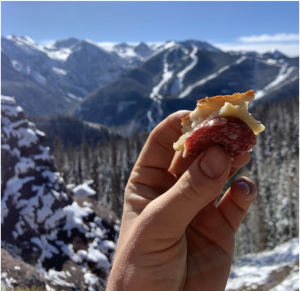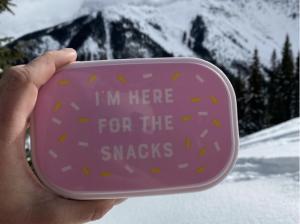In a piece for the Telluride Daily Planet, ski and alpine guide Maddie Crowell explains how she snacks for peak performance in the mountains. Check out her full piece here.
Snack Often (aka avoid the Hanger)
Snack breaks are arguably the best part of snacking. It’s important to snack well, but also often. Most of us are used to eating when we’re hungry, but that won’t fly when you’re on a big mountain adventure or are working your body super hard. It’s important to snack about once an hour to maintain the body’s blood sugar levels. Snacking is the best way to avoid a bonk or energy crash. We want to avoid any chance of getting hangry (think anger derived from being hungry, very similar to cranky symptoms). I like to think of my body as an engine: if I let it run out of gas I won’t be able to travel very far. Therefore, I want to constantly keep refueling in order to sustain any type of endurance. On big days, I try for 100-200 calories every hour and that seems to do the trick for me!
Don’t Underestimate the Classics
2022 is a world full of snacking options. There’s an ongoing evolution of snacks from bars to gels to chews to the newest all organic-vegan-sustainably produced chocolate. We love the snack evolution, but I’m also here to remind you that PB&Js, cheese and crackers, salami, jerky and trail mix have been fueling athletes throughout the ages. So, don’t underestimate the classics, and never be too good for cheese and crackers.
Snack with Variety
Bring the sweets, bring the salty, bring the protein. No matter how long the adventure, you want to bring a variety of snacks. It’s hard to tell what your body will crave on the first hour of the day versus the last. You don’t want a pack full of only Solo Bars or one giant bag of trail mix. I find that when I have a variety I’m more likely to maintain my once an hour snacking goal (see Rule #3). This way, near the end of the day, I’ll have something I want to eat, which is usually the most crucial time to get food in the body to avoid that bonking syndrome (again, see Rule #3). On bigger missions, multi-day trips or expeditions, your body might crave salt and protein at lower elevations and easier to digest things like candy and sugar higher up. Plus, when you have a variety of snacks you can play “surprise snack” and reach randomly into your snack bag to pull out a surprise snack!
Snack Sustainably

It’s 2022. If you haven’t gotten the #gogreen memo, it might be time. I love using re-suable containers and beeswax wraps to help me steer clear of plastic bags. I also try to be in the mindset of pack it in, pack it out. I carry out all my trash and never leave apple cores or orange rinds on the ground. In an alpine or snow environment it can take years for a rind to biodegrade.
The Emergency Snack
It’s happened to all of us. We took a wrong turn or our time estimates are hours off. Now when we reach into our snack bag to play “surprise snack” we feel nothing. Don’t panic. Always have your emergency snack. For some, it’s a Snickers bar that’s been in the bottom of your pack for two years. For others, it’s an emergency can of sardines that’s going to get you to the top, or to go home. Keeping an emergency snack stashed in your kit is a good call for when trips turn into real adventures.



